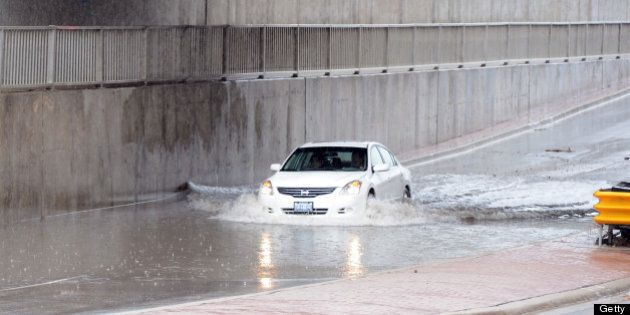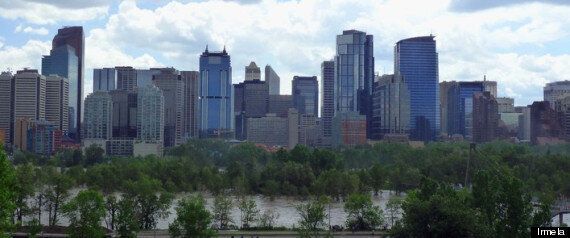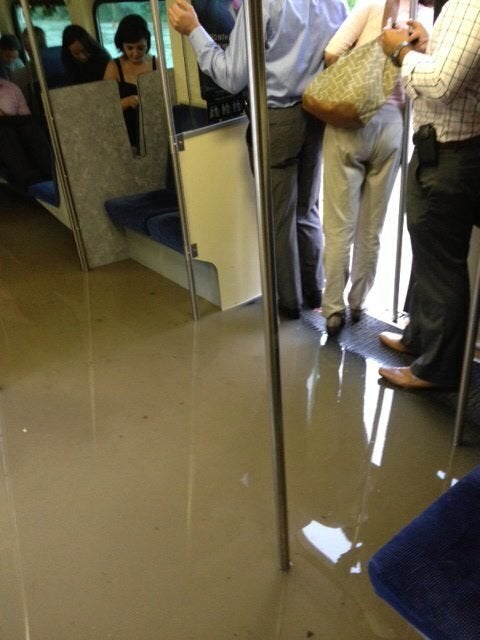
Over 1,000 planners descended in Vancouver this past week at Infuse, this year's conference for the Canadian Institute of Planners. The requisite jokes about Vancouver's weather introduced many speakers' remarks.
This time, however, the fact that sunny, cloudless weather had blessed the 'Wet Coast' was keenly felt by delegates from Alberta, who had just experienced the 2nd flood of the century in Calgary and devastation in High River.
The delegates from the Greater Toronto Area also came to join them in their commiserations as Mississauga and Toronto were assaulted with 126 mm of rain in the span of a few hours on Monday. Climatologists and insurance companies alike predict that these previously rare 100 year events will happen more frequently and with greater magnitude.

Most everyone can agree that climate change is occurring, with some debates raging over whether it is happening quickly or slowly.
We reached a significant milestone this May when carbon dioxide levels in the atmosphere surpassed 400 parts per million for the first time in human history. The question is no longer how we can stop climate change from happening, but what we can do to adapt and rebound from its effects, a concept called resilience.
To be resilient, a system must have redundancy, connectivity, and diversity. Redundancies allow a system to perform as expected and tolerate a certain level of disruption. Connectivity increases redundancies by facilitating flows of resources, people, and information.
A diversity of options allows the system to adapt to a myriad of different and unexpected forces. There are many ways in which cities can become more resilient and two approaches stand out for me in light of the conference: first, engage with and build capacity at the local level; secondly, address the infrastructure deficit in ways that build a system's innate levels of redundancy, connectivity and diversity.
Mary Rowe, Vice President and Managing Director of the Municipal Art Society of New York, was a panelist at Infuse and guest speaker at a talk on Community Resilience sponsored by Bing Thom Architects and UBC.
Rowe showed us the incredible activity and connectivity of people hit by disasters. Post-Katrina New Orleans was a wealth of resourcefulness, tenacity, and creativity in a place that was grossly neglected by the Bush administration.
Low-tech examples of community hubs, information boards, and maps were essential for communicating among survivors. As electricity and the Internet came back, residents were able to compile their own open-data inventory of survivors, conditions and housing that became the trusted source of information over federal sources.
Bloggers came together to document lost heritage, reconnect vulnerable populations to urban agriculture and local commerce, and to be a resource for others to rebuild.
In Toronto and Calgary, social media platforms were filled with images and videos way before traditional media outlets. In Toronto, power was lost around the media centres in the downtown core making smartphones the default source of information. Friends announced to their networks whether they were evacuated, out of power, and where roads had become flooded.
As the flood waters receded in Calgary, citizens rallied to help with the clean-up effort, mobilizing thousands through Facebook groups and websites .
From a top-down perspective, communities are sometimes seen as entities to be managed or an uninformed audience that needs educating. These examples show that communities should be seen as local experts, decision-making partners and loudspeakers in times of disaster.
But even as community cohesion is the most granular level of this story, communities are made vulnerable by the geographies, politics, and social contexts in which they are embedded. Infrastructure is one critical way in which communities are sustained and are therefore vitally important to resilience.
The highest priority for adaptation as identified by Canada's Adaptation Advisory Committee and other organizations is infrastructure.
In March 2013, the federal government agreed that they would put $53 billion towards infrastructure upgrades and replacements in the next 10 years; however, due to chronic underfunding of infrastructure since the 1960s, Claude Dauphin, president of the Federation of Canadian Municipalities puts the infrastructure deficit more at $200 billion.
The replacement of Canada's aging infrastructure in the oncoming years may be an opportunity for cities to put in infrastructure that considers new tolerances that have exceeded past calculations for 100 year events. Engineers are also rethinking the way that old infrastructure can be reinforced rather than entirely rebuilt as the intensity, frequency and timing of weather events has changed.
Nature cannot be completely kept out since our cities and built areas have simultaneously become more dense and spread out. The thinking now is to allow for acceptable spillovers that creates a fuzzy boundary between natural and man-made environments. We also need to reassess where we put our critical infrastructure. As Toronto, Calgary, and High River have shown us, our highways, homes, CBDs, and mass transit routes are located in floodplains. How can cities become more resilient with these fixities in place?
Toronto's Chief Planner, Jennifer Keesmaat wisely chose Resilience as a topic for one of the Chief Planner Roundtables earlier this year where they discussed these very same strategies. City engineers, local Councillors, and consultants all agreed that to enhance Toronto's resilience, they needed to build in redundancies by way of understanding interdependencies, putting back-ups in place and raising public awareness.
The latter was especially needed in order to alter user behaviour with regard to how land, water and energy are consumed. The participant identified a number of tools that could help make Toronto more resilient. Energy management technologies such as smart grids would be able to better predict and manage user demand while renewable energy sources such as solar panels and district energy would put more points of supply into the system, helping prevent power outages.
Ecological design such as bioswales, permeable pavements and green roofs would help slow down the flow of precipitation, mitigating the sudden, high-volume influx into the stormwater management system that causes overflow. With an understanding of these strategies and technologies, the challenge lies in how Toronto and other Canadian cities will fund investments in their infrastructure.
In light of the popular appeal of small government and minimized government responsibility, the disasters in Alberta, Ontario and Quebec make one wonder how much the governments at all levels in Canada have helped in the disasters in the span of 3 weeks through rescue, reconstruction, and aid. Also speaking at the Community Resilience talk, 6-time Vancouver Councillor and current director of SFU's School of Urban Studies Gordon Price defended the role of governments in city-building and disaster management. Government's mandate, Price said, is to foresee and secure public benefits and to take on the risks associated with producing those benefits on behalf of its citizens, such as with large infrastructure projects like water treatment plants.
However, to date, federal and provincial governments in this country have been unable to produce unified goals and strategies related to many pressing issues such as greenhouse gas emissions, housing, transit and infrastructure.
It is precisely at the federal and provincial levels that infrastructure plans need to be drawn up as these platforms are more suitable for large, costly, long-term projects. Instead, the mandate of governments seems to have been reduced to respond reactively, to rescue and to reassure in times of disaster.
What's worse is that the disaster in Alberta could have been minimized. Flood mitigation recommendations were made after the 2005 flood in a provincial report published in 2012 and by engineers and scientists since the 1980s. A combination of governmental fiscal restraint and resistance to implications of floodplain designation made these recommendations unpopular.
Another important aspect of resilience is psychological. People must also change their mindsets and anticipate change, which lowers the stress associated with a novel or unexpected event and allows us to better problem-solve. Perhaps the floods that first hit Calgary, the energy capital of the country, and Toronto, its largest city, will be a wakeup call that cities are becoming increasingly fragile and that action is needed.
